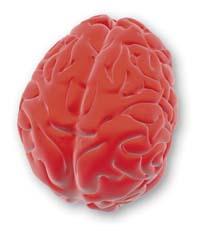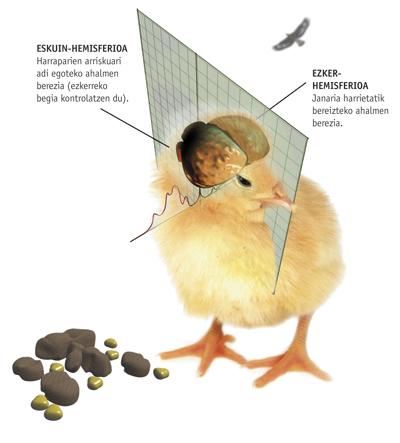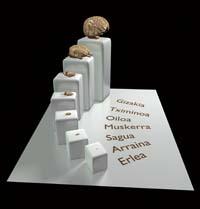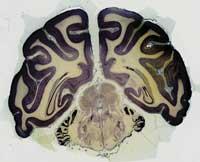On one side and on the other
2010/01/01 Roa Zubia, Guillermo - Elhuyar Zientzia Iturria: Elhuyar aldizkaria

Advantages and disadvantages of the proper functioning of each brain hemisphere
He is eating a chick. On the ground there are several grains of cereals, scattered over an area of small stones. Chita's brain has to make a small effort to separate the grains from the stones, but it is not very difficult. However, he is not calm, he feels a predator nearby and fears. While searching for copies, he is willing to escape at full speed.
In fact, you should not be afraid of the predator, as it is in a laboratory of the University of New England, in Australia, in the research center of Animal Behavior and Neurosciences. But he does not know what a research center is and does not know that there is no danger. Therefore, when eating the grain should be attentive to possible predators. You have to do two things at the same time.
Thanks to this type of experiments, neuropsychologist Lesley Rogers of this center made a surprising discovery: the chick spies much better than a predator with a predator on his left. The left eye is a good watch and the right eye easily separates the grains in the ground, but in reverse position, the chick has more problems.
That is, Rogers discovered that the chick uses different cerebral hemispheres. Chites have laterality in the brain. And not just the chites. "It happens in many species. They use the right hemisphere to respond to novelty and the left to classify stimuli and select them among the options."
According to experts, this laterality is essential to be able to do both at the same time. If the chick had a symmetrical brain, that is, if what he does with the left hemisphere did exactly the same with the right hemisphere, he would not have the same ability to do two things at the same time. Asymmetry is more complex than symmetry and brings advantages to chit.

However, the laterality of the brain does not appear in all animals; in some species, some specimens have the lateralized brain and others do not. Therefore, neuropsychologists consider that an asymmetric brain not only provides advantages, but also disadvantages.
Small fish
In Italy, Marco Dadda and Angelo Bisazza of the University of Padua have tried to identify the disadvantages of laterality in tropical fish Girardinus falcatus. They are small fish, a few centimeters long and, like many others, have an eye on each side of the body.
This feature is important because what you see with one eye does not see with the other. And that means the image that an eye receives is processed by a single hemisphere of the brain. The brain does not confuse images.
Padua researchers have discovered that laterality is a disadvantage when they have to simultaneously use the information of both eyes. For example, the predator image may reach the hemisphere with less ability to escape predators. Instead, fishes with symmetrical brains are given no matter where predators come from, the brain will respond equally and those with lateralized better than when they come on the worse side.
In this case, brain complexity is a disadvantage. Padua researchers wrote Proceedings. In the specialized journal Biological Sciences.

Having one eye on one side and the other, the case of fish is very clear. The same goes for chites. But the disadvantages of laterality have also been found in animals with front eyes. Apoos, for example, escape more easily to the predator coming on the left than to the one coming on the right. However, in the case of toad (and many others) the advantages of laterality compensate for the disadvantages.
Simple brains
Without seeking concrete advantages or disadvantages, there is another way to address this issue: to seek laterality. In recent years neurobiologists are working on it. They look for species that have triumphed in evolution thanks to the lateralized brain. The smaller and simpler the species in which the asymmetric brain is, the more successful the laterality has been.
But the search for asymmetric behavior of these species is not so easy. It is easier with chites, fish and toads, due to the complexity of the brain and its more complex behavior. But researchers should study, for example, whether spiders and insects more easily practice an activity on their left or right side.
The team of researcher Pinar Letzkus, at the National University of Australia, found a way to demonstrate that bees have laterality. If one antenna gets wet in latex, the bee cannot use it and must adapt to the other. Thanks to this, the researchers discovered that the bee has a great learning capacity using the antenna on the right, but that it has little learning capacity with the left.

And the team of Lesley Rogers, in collaboration with Giorgio Vallortiga of the University of Trento, later led the research. "We have shown that bees use the two antennas to remember odors; just learn to know the smell, remember it with the one on the right, but six hours later use the left antenna to remember the smell," says Rogers.
The team led by researcher Alberto Pascual, at the IBIS institute in Seville, obtained a similar result with the fly Drosophila melanogaster. Most flies have an asymmetric brain, they do not have the two hemispheres exactly the same. But in a few flies there are no differences. "These few specimens with symmetrical brains are not able to fix long-term memory," explains Pascual. They believe that the asymmetry of the brain is necessary to fix a long-term memory. And having this memory is an obvious advantage to the changes. "Without long-term memory, the fly is more dangerous! ".
More complex brain
Cerebral asymmetry has been found in flies and bees. But it is not clear where the limit of laterality is, that is, from what species the asymmetric brain begins on the scale of complexity. However, it is very clear that nature's most complex brain is human. And that is lateralized.
The most widespread idea about human laterality is that the left hemisphere is capable of dealing with analytical concepts, while the right is the sentimental hemisphere. But psychoeurology has long discovered that this is not so, but is like the animal laterality of the human being. Similar, but more complex, of course.
The left hemisphere performs the necessary tasks with a sequence of steps. It is the process of speaking, for example. The brain must search for words, apply the rules of a grammar, complete the sentence and say the phrase. All this is done in that order, it is a sequence.

The right hemisphere, for its part, carries out the work to be analyzed as a whole. The example is the knowledge of the faces. You cannot know a friend's face in a sequential way (first eyes, then eyebrows, then nose, etc. ), but through a study of the whole face.
It is the same case as chicken chickens. Txita spies the predator in a sequential way, analyzing at all times the location of the predator (with the right hemisphere). But you must analyze the integrity of an image (with the left hemisphere) to separate cereal grains from stones.
Like Chita, laterality brings important advantages to the human being. Moreover, in the outer layers of the human brain the laterality is greater than in the interior. It is clear that in these levels of complexity the advantages are much greater than the disadvantages. But on the other hand, the human being is an animal, and it is not surprising that in brain characteristics there are animal characteristics. Laterality is one of these characteristics.

Gai honi buruzko eduki gehiago
Elhuyarrek garatutako teknologia






